All About Lord Ganesha

Take Part in the Visarjana (Immersion): Click on the Coconut and Immerse Ganapati with mouse and keep up the tradition
Vakrathunda mahakaaya
Suryakoti samaprabha
Nirvighnam Kurumedeva
Sravakaaryeshu sarvada
(You of the twisted trunk and the massive body. With the dazzle and light of millions of suns. Lead me on a path that has no obstacles and hindrances. Clearing the way in all that I do and always)
VIGHNAHARTA MORAYA
RELIGIOUS THINKERS HAVE ASCRIBED MEANINGS TO EACH PART OF GANESHA'S FORM
The curled trunk: The symbol Om, intellect and the faculty of discrimination.
The elephant's head: Superior intellect.
Snake around waist: Cosmic energy.
Broken tusk: Knowledge.
Large ears: To separate the real (Brahman) from the unreal (Maya) in life.
Head: Previous wisdom through sravana and manana.
Human body: Supreme wisdom.
Large belly: One who digests all types of experiences.
Leg on the ground: Dealing with the world while ever-rooted in single-pointed
concentration upon the supreme reality.
The food: Material wealth, power and prosperity.
Mouse: Desire.
Riding on his rat: A man of perfection trying to use his limited body, mind and
intellect.
Ganesha's four arms: Four inner equipments of the subtle body, namely mind
(manas), intellect (buddhi), ego (ahamkar) and conditioned consciousness
(chitta).
Axe in the hand: Destruction of all desires, attachments and their consequent
sorrows and agitations.
Rope: To pull the seeker out of his worldly entanglements and bind one to the
everlasting and enduring bliss of one's self.
Modak: Joyous rewards of spiritual seeking.
A lotus padma: The supreme goal of human evolution.

People are under the false impression that today is the birthday of Vinayaka, but He has neither birth nor death. He has neither beginning nor end. He is the eternal witness.
Sri Sathya Sai Baba has said that on this sacred day of Vinayak Chaturthi, people spend lot of money in offering various fruits to God. All these offerings are made only as a ritual. Ultimately people themselves consume them. Pathram, Pushpam, Phalam and Thoyam - these are the four things that you should offer God. Here Pathram (leaf) means body. This body may wither away at any moment. So never develop attachment towards the body; instead offer it to God. Pushpam (flower) means Hridaya. This flower will never fade away. Mind can be compared to Phalam (fruit) and Thoyam stands for tears of joy. Hence all these four should be offered to God.
Three basic sounds - a, u, m - form the origin of all sounds. The three combined constitute Aum, called pranava emanated from Brahman, the supreme soul of the universe. It is from sound that all earthly forms are born. It is as the symbol of pranava that Vinayaka began to be worshipped.
In Tamil Nadu, Ganesa has come to be known as Pillaiyar, because he is the pillar or son of the parents of the Universe, Parvati-Parameswara .
By indicating to mankind the goal of human evolution and the path to reach the same, Lord Ganesha occupies a place of distinction in the Hindu pantheon." Ganesha or Vignaharta shows humanity its goal not only with his teachings, but also his physical appearance. So, the artisan's final touches to Lord Ganesha's idol for Ganesh Chaturthi, being celebrated on August 22, are crucial as each part of the popular God is symbolic and open to philosophical interpretations.
THERE is a deeper meaning to the form of Lord Ganesha that can be understood when we dwell a little on the symbolism. To contemplate on the formless and transcendental essence, some of us need an idol that can be seen and worshipped. Thus the idol represents an ideal, a medium for us to get in touch with our spirituality. So let's take a look at Ganesha's symbolic representation in our scriptures and what they mean to us.
Our ancient seers or rishis discovered a basic unity or harmony underlying all of life and its forms despite the apparent chaos Life has three stages of evolution, according to Vedantic thought: Birth, growth and death - the trinity, a continuous chain taking place again and again, with progress achieved in each scale of evolution. And one supreme power controls and guides this.
Our sages with their rich imagination, foresaw obstacles in cosmic progress, and installed the first Worn of Shiva, the destroyer, and his consort Parvathi, as the god to be propitiated, for removal of obstructions and to achieve success in any work undertaken. This god is none other than Ganesha. His name is invoked before starting any new venture. He is called Vighneswara, the lord who is the remover obstacles. He is also called Ganapati, the leader of Shiva's servants or ganas Vinayaka, the supreme leader. He is the master of knowledge or vidya, and the champion of worldly achievement, avidya.
Ganesha is depicted generally in a seated pose. It signifies that in him the mind and intellect are totally integrated. The entire world is at his feet, waiting for his command. The pose also resembles that first primeval cosmic sound in Sanskrit – OM – the beginning of creation itself. He has a bulky body, symbolic of the entire cosmos. This big belly symbolizes space. The mastermind has to digest all experiences of life. The snake around his expansive waist is like a girdle. It symbolises energy in all forms.
"In Hindu mythological literature Ganesha is described as having a human form with an elephant's head. An elephant's head on a human body indicates supreme wisdom. The two main steps of spiritual education are sravana, which means listening to the eternal truths of Vedanta and manana, which is reflection upon those truths. And the large ears and head of Ganesha indicate that He has acquired spiritual wisdom through both the steps.
He has an elephant's head, symbolic of the intellectual capacity one must have to understand the supreme truth. The large ears are symbolic of the sravana or careful listening one must give one's teacher, to understand Vedantic truth. Not only must the student understand the concepts, he must also have the sensitivity and the discriminatory power to distinguish the mortal from the eternal, impermanence from permanence, the gross from the subtle. This is symbolised by the trunk that starts from Lord Ganesha's forehead. An elephant's trunk can lift a log of wood as well as a blade of grass. The two tusks on either side of the trunk are symbolic of right and wrong, good and evil. Ganesha possesses the faculty of being aware of the duality of the world.
The crooked trunk of Lord Ganesha wbich also gives him the name Vakratunda, too has an interesting meaning. The trunk, which is able to uproot a tree and also lift a needle, represents Lord Ganesha's intellect. A man of realisation like Ganesha is one who has fully developed both his gross and subtle intellects. "He has perfect understanding and knowledge of the terrestrial as well as the transcendental". "Also, Vakratunda is one who punishes those who follow , the wrong path and leads them to the path of righteousness".
But one tusk is broken. This means that as the perfect student, he has gone beyond the pairs of opposites, beyond the subjective and the objective to a higher plane of consciousness. The broken tusk also symbolises that nothing is too precious to be sacrificed for intellectual progress.
Ganesha holds in his four hands an axe, a rope, and a rosary of beads, while the last hand is held up in benediction. With the axe, he cuts off the worldly attachments of his disciples. The rope brings them nearer the path of truth. The beads remind one of the continuous pursuit of supreme knowledge that the believer should engage in. His trunk holds the sweet stuffed riceball modak. It is symbolic of the self that resides within us and which has to be realised by each one of us. The fourth hand blesses his believers for success and joy through life's journey. On another level, the obstacles in life subjective and objective can be surmounted and realisation attained with Ganesha's blessing. The modak signifies the sweet satisfaction one gets in travelling the spiritual path.
The large belly denotes a perfect human being one who can "consume and digest" life's experiences, both good and bad. A balance between material and spiritual life is represented in Ganpati's sitting posture, with one leg folded up and the other leg resting on the ground. "The leg on the ground indicates that one aspect of his personality is dealing with the world while the other is ever rooted in singlepointed concentration upon the supreme reality".
Though His body is of gigantic proportions He is yet a child. It is paradoxical that with such a massive body, Ganapathi should have chosen the tiny mouse as His vaahana or vehicle.
This conception of Vinayaka riding a mouse is illustrative of the Vedantic truth that God alone matters and that all other external paraphernalia are illusions.
The mouse, at the feet of the lord symbolises material desires that can destroy the good within us. Though it's a small animal, it can play havoc with many things – foodgrains for one. Ganesha has subjugated this mouse of desire and kept it under control.
"This mystical form of Lord Ganesha represents not only the supreme state of human perfection but the practical path to reach that state. The details of his description suggest deep philosophical significance which can guide you to reach that ultimate state."
Ganesha thus represents, "The perfect wisdom of a fully realised vedantin a follower, or student of Vedanta. He is the highest and the best that has ever been given in our scriptures". Ganesha has an important position because he is invoked not only by Hindus at the beginning of any work, but even the other gods in the Hindu pantheon pray to him, according to the puranas.
Hasthasya Bhooshanam Daanam
Kanthasya Bhooshanam Sathyam
Srothrasya Bhooshanam Saasthram
Bhooshanaihi Kim Prayojanam
Charity is the ornament for hands.Truth is the ornament for speech.
Hearing the scriptures is the ornament for ears.
Where is the need for other ornaments?

EMBODIMENTS OF LOVE!
There is no greater experience than the feeling that one is Atma (Aham Ethath). Aham (I) is defined as Atma, the Self. The word "Ethath" means "all these". It covers all the objects in the Universe which are physical and subtle and also the Sun, Moon, stars and planets. It signifies that you are not the physical body. You say "my body" which implies that you are not the body. What is this body constituted of? It is a combination of the five elements (Pancha bhootas), five Vital Airs (Pancha Pranas) and the five sheaths (Pancha Kosas). The entire universe is the body of the Supreme Lord. It consists of all the moving and static things. It is deemed to be superior Wisdom (Jnana) when you say "I am not the body".
DRISYA AND DRASHTA
One should be extremely fortunate to realise this. Whatever you see in the external world is "Drisya" (that which is seen). The Sun, Moon, stars, the five elements which constituents of the universe are all "Drisya". You are seeing your body too as you see other things. So the body is also "Drisya", that which is seen by you. Who is then the seer? The seer is "Drashtra". The body is the object and you are the seer. Without a seer there is no question of anything being "seen". Some people talk about "Soonya" or emptiness or nothingness. Unless this has been seen, how can they talk about 'Soonya'? Knowledge of the seer and the seen is the great message of Ganapathi, whose advent we are celebrating today. 'Ga' means Buddhi or intelligence. 'Na' means Vijnana or wisdom. 'Pathi' means master. So, Ganapathi is the master of all knowledge, intellegence and wisdom. There is also another significant meaning for the word, that He is the Leader of all the 'Ganas' who are celestial beings. He is also called 'Vinayaka', which term means that he is one who has no master above him. He is the Supreme Master. He is beyond the mindless state. One who has stilled the mind cannot have any master.
Without understanding this truth, we think of the physical form of Vinayaka with the elephant head and human body. Whenever people want to commence any undertaking or start learning music or the find arts or any branch of knowledge, they first offer worship to Vinayaka.
SIDDHI AND BUDDI
He is also called Lambodara, which means 'Guardian of Wealth' (Lakshmi Swaroopa). Here Lakshmi represents all wealth and prosperity and not only Dhanam (money) for which there is a separate deity called Dhanalakshmi, one of the eight Lakshmis. Here wealth means Sukha (pleasure) and Ananda (bliss). What is the use of having all other things when one has no pleasure or bliss? Ganapathi is the one who gives us spiritual potency and endows us with Supreme Intelligence.
These two are termed as Siddhi and Buddhi respectively. Siddhi and Buddhi are described as his two consorts. As he is the Adhipathi or Master of Sidhi and Buddhi, he is regarded as their husband in mundane terms. Vinayaka has no desire and hence there is no need for Him to have wife and children. He is worshipped by people in this country since very ancient times. There is historic evidence that the worship of Vinayaka has been in vogue even in other countries such as Thailand, Japan, Germany and U.K.
Adoration of Vinayaka as a principal deity (Prathama Vandana) has been mentioned in the Vedas. Ganapathi Thathwa finds a place in the Vedas and Upanishads. Reference to Him is made in the Gayatri also. He is the one who instil purity in the body, and fearlessnes in the mind. It is said: "Thannoa Dantah Prachodayaath", giving importance to his tusk.
Some people, out of ignorance, comment upon the big animal form of this Master Deity and question how one with such a huge form can ride on a small mouse (Mooshika) which is depicted as His vehicle. "Mooshika" is symbolic of the darkness of ignorance, while Ganesha signifies the effulgence of Wisdom that dispels the darkness of ignorance.
STEAM-COOKED OFFERING
Even the offering that is made to Ganesha has great significance because it is prepared with gram flour and jaggery or pepper and enclosed in an outer covering made from flour paste and then cooked in steam without using oil. This is supposed to be a healthy and delicious food item according to the Ayurvedic system. Modern doctors also recognize the importance of such steam-cooked idlis (Rice cakes) which they recommend as post operative diet for patients as it is easily digestible. Jaggery too has the property of controlling gas formation and this food item gives relief from eye troubles and prevents gastric disorders.
In the ancient traditional mode of observing these festivals, great emphasis was laid on good health as the pre-requisite for spiritual pursuits with a healthy mind. For achieving the four goals of human life, Dharma, Artha, Kama and Moksha, (Righteousness, Wealth, Desire, Liberation), one should have basically a healthy body. If you want to earn wealth by righteous means and cherish desires which lead to liberation, you should have sound health.
Vinayaka is also called Vigneshwara as he removes all obstacles coming in the way of devotees who pray to Him sincerely. He is worshipped by students with books so that all that is contained in the books may get into their heads.
Now-a-days people are only after money (Dhanam). Whatever scholarship one may attain, whatever power and position one may enjoy, one cannot be happy without the peace of mind that is got by pure devotion. One may have immense physical strength, one may pursue the path of meditation and penance, one may acquire profound knowledge, but all these attainments will be of no avail unless one acquires knowledge of the eternal - Sathyam, Jnanam, Anantham, Brahmam.
THE ELEPHANT SYMBOL
The symbolic significance of Ganesha's elephant head has to be properly understood. The elephant has profound intelligence. For example, yesterday Sai Geetha, (Bhagavan's elephant) came running when it heart the sound of Swami's car approaching. Though many cars were following Swami's Car, Sai-Geetha could unmistakably identify Swami's car from an uncanny recognition of the sound of the car. That is why it is termed "Gaja Thelivi' (elephantine intelligence). One having a sharp brain is described as having the intelligence of an elephant. It has "Medha Sakthi' Moreover, the elephant has large ears and it can hear even minute sounds. Sravanam or hearing the glory of the Lord is the first step in spiritual Sadhana for which ears should be sharp. After hearing one has to ruminate over this and put it into practice (which are termed as Sravana, Manana and Nidhidhyasana). The elephant takes the praise and blame equally (Dooshana and Bhooshana). When it hears something bad, it moves its body this way and that way and shakes off the unwanted things while it retains good things quietly.
Only Vinayaka teaches the lessons that are essential for mankind. You should not stop with installing the idol and doing Pooja for a few days. You should make efforts to become a Nayaka or Master over yourself. You have the nine-fold path of devotion. Sravanam (Hearing) Keerthanam (Singing His glory), vishnornamasmaranam (thinking of and chanting the name) Paada Sevanam (Serving at his feet), Vandanam (Obeisance) Archanam (Worship) Daasyam (Serving Him as a servant serves the Master), Sakhyam (befriending God), Athmanivedanam (surrendering body, mind and soul). The elephant signifies combining of the first and the last, that is, Sravanam and Athmanivedanam, so that all the other paths in between are covered fully.
When a man is born he does not have round his neck any necklace of pearls or gems or any possessions. But he is endowed by Brahma with the garland of the effects of his past actions, good or bad, which hangs invisibly around his neck. If you do good you will enjoy good results and if you are bad you will not escape suffering the consequences thereof.
THE LESSONS OF SACRIFICE
The teachings of Vinayaka is one of sacrifice. You may not heed the contents of the Puranas, but you should not miss the vital principles which they convey to mankind.
When Vinayaka was writing the Mahabharata to the dictation of Sage Vyasa, the latter laid down the condition that Vinayaka should go on writing non-stop whatever Vyasa said. But Vinayaka also stipulated a condition that Vyasa should never stop his dictation but should go on without a break. While he was writing, Vinayaka's pen broke and he did not hesitate to break one of his tusks to use it as a pen. That is why he is called Ekadantha or one with a single tusk. This is a shining example of the spirit of sacrifice that Vinayaka exhibited for the welfare of humanity. That is why the Vedas proclaim that it is only by sacrifice one can attain immortality.
Love and sacrifice (Prema and Thyaga) constitute Bhakti (devotion to God). There is nothing superior to this. Athma Jnana (Knowledge of the Self) is essential. This was the main teaching of Adi Sankara throughout his life, as He was preaching and following the Vedic dictum: Ekaathma Sarvabhoota - Antharathma". "Ekam Sath Vipraa Bahudha Vadanthi" ("The one Atma is present in all beings." "The one Truth is described in many ways by the wise.") He was also preaching that Jnana or Wisdom was nothing but "Adwaitha Darsana" (Vision of Non-duality). But, during his last days, Sankara realised that Bhakti was greater than Jnana. In his famous "Bhaja Govindam", Adi Sankara emphasises that only the path of devotion will help you to get over the cycle of birth and death.
THE GREATNESS OF BHAKTI
There is no path superior to that of Bhakti. Bhakti does not mean doing pooja, bhajans, going on pilgrimage to holy shrines etc. Bhakti means diverting the pure and unsullied mind towards God. People do not know the real meaning of "Prema" (Love). The love you have for other beings is only temporary. God is the only one that is eternal. Love of God is Bhakti. All other love may be termed as Anuraga, which results in bondage, while Love of God leads to liberation.
One may raise a question whether it is possible for everyone to realise the goal through the love of God. One may not achieve this instantaneously, but can do so progressing step by step. By Bhajans and other forms of worship one may advance towards the goal of final emancipation. There is no meaning in saying that one is searching for God. It is God who is searching for a true devotee. This is as true today as it was in the past. God is neglectd by people when He is easily attained. What is easily obtained at home is not relished so much as what you get outside, though it is not wholesome. In olden days, people going on pilgrimage to Tirupathi used to climb the hills step by step chanting the name "Govinda, Govinda" as they climbed each step. Thus the pilgrimate was performed with sincere devotion and Namasmarana. But, these days people go by buses an cars, gossiping all the while, and indulging in unholy pursuits. The tonsure ceremony in which one shaves his head completely and offers his hair to the Lord of Tirupathi signifies your giving up your Thamo-Guna (ignorance and lethargy) which is symbolised by the hair on the head. The hair is black. Giving up the hair indicates giving up Thamo Guna. You have to assimilate Sathwa Guna.
All acts of worship have a spiritual significance. Now-a-days, people do not understand their inner significance, but give up not only their hair but also waste a lot of money and return home without being any the wiser for the trip.
You may install idols and worship them. But do not forget the inner significance of all worship. All external activities are necessary only to help you to get into the spirit of non-duality and experience unity and diversity. Love and sacrifice are very important. Where there is pure, unsullied, selfless, sacred and sublime love there is no fear at all. Giving and not getting is the underlying principle of Spiritual Sadhana. Your heart is full of love, but you are using it only for selfish purposes and diverting it towards God. God is in the heart and not in the head. The heart is (premamayam) full of love. One these festivals days, you should remember that God is one, and all religions uphold the same principle of "One God, who is omnipresent." You should not have contempt for any religion, as each is a pathway to God. Fostering love towards your fellow-beings, receive the noble love of the Divine. This is the goal of life.
GANPATI BAPPA MORIYA

EKADANTHAAYA VIDHMAHEE
VAAKRATUNDAAYA DHEEMAHI
THANNO DHANTIHIH PRACHODAYAAT
According to the Indian Convention, Ganesh is the prime most deity whom everyone of us must worship first since He is the reliever of obstacles, giver of wisdom and all boons and finally bestows liberation on all those who seek His Grace, and thus cuts asunder the worldly bondage. The Indians are of the firm belief that no success can be achieved without first paying obeisance to Lord Ganesh. So those who aspire wordly and spiritual success in their life should first start their prayers to Lord Ganesh. Adoration of Vinaayaka as Prathama Vandhana (First Deity to be saluted) has been mentioned in the Vedas. Reference to Him is made in the Gayathri also. He is one who instills purity in body, and fearlessness in the mind. It is said "Thanno Dhanthih Prachodayaath" giving importance to his tusk. He rides on a small Muushika (mouse). Muushika is symbolic of the darkness of ignorance, while Ganesha signifies the effulgence of Wisdom that dispels the darkness of ignorance.
Lord Ganesh is the elder son of Lord Shiva and Goddess Parvati. Shiva is the one who removes and destroys all evils in the world. Parvathi is the Goddess of Sarvashakthi, who helps in his work. He is also affectionately known by many other names like Vinaayaka, Heramba, Siddhivinayaka, Gajamukha, Vigneshvara, Lambodhara,Gajanana, Ganpathi etc.
What does the term Ganapathi signify? 'Ga' means Buddhi (Intellect). 'Na' mean Vijnana (Wisdom ). 'Ganapthi' means one who is the Lord of the intellect and wisdom. He is also the Lord of all Ganas (spiritual entities). Ganas also symbolise the senses. Ganapathi is thus the Lord of the senses.
It is only when the man is pure that the intelligence blossoms. It is only with the blossoming of intelligence that Siddhi (the spiritual goal) is attained. Vinayak presides over the the Buddhi and Siddhi (the intellect and the spiritual realisation). The scriptues say that Siddhi and Buddhi are the consorts of Vinaayaka and Kshema and Anandha are his two sons. Siddhi and Buddhi symbolises the powers of attraction of Ganapthi.
Vinayaaka is known for his supreme intelligence. He has the head of an elephant. The elephant is also known for its high intelligence. The elephant will not trust anybody except its master. Because Vinaayaka is endowed with exceptional intelligence, His elephant face is symbolic of supreme intelligence. Vinayaaka also mean that He is the one who has no master above Him. He is the supreme master. He is beyond the mindless state. One who has stilled the mind cannot have any master.
He is also called Lambodhara which means Guardian of Wealth - Lakshmi Svaruupa. Here lakshmi represents all wealth and prosperity and not only Dhanam (money) for which there is a separate deity called Dhanalakshmi. Here wealth means Sukha and Anandha (pleasure and bliss). What is the use of having all things when there is no pleasure and bliss?
Vinaayaka is also called Vigneshvara as He removes all obstacles coming in the way of devotees who pray to Him sincerely. Only Vinaayaka teaches the lessons that are essential for mankind. One should not stop with installing the idol and doing pujas for a few days. One should make efforts to become a Naayaka or Master over onself by practising the nine-fold path of devotion.
He broke his tusk to use it as a pen when He was writing the Mahaabhaaratha to the dictation of Sage Vyaasa. He is a shining example of the spirit of sacrifice that He exhibited for the welfare of the humanity. That is why he is called Ekadhantha or one with single tusk.
Another well known Ganpathi Mantra is illustrated below:
VAKRA TUNDA MAHAAKAYAA SURYA KOTISHA SAMAPRABHA
NIRVIGHNAM KURU ME DEVA
SARVAKAARYESHU SARVADAA
| Vakra tunda | Twisted trunk |
| Mahakaaya | Huge, mighty body |
| Suryakoti | Equivalent to lustre of crores of Sun |
| samaprabha | i.e the effulgence of his intelligence outshines crores of Suns |
| Deva | Oh, Lord |
| Sarva Kaaryeshu | Always and in all works (action) |
| Nirvighnam Kurume | Remove all the obstacle |
Oh, Lord, with a twisted trunk and a huge might body, who lustre is equivalent to that of a crores of Suns, (whose intelligence always outshines crores of Suns) I pray to thee, O lord, always remove all obstacles from the good actions I perform.
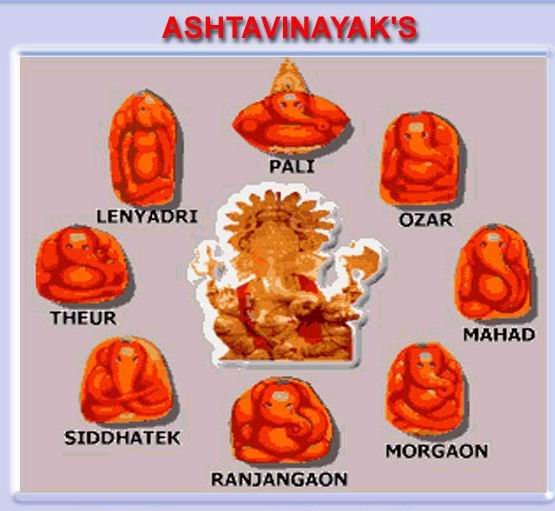
108 NAMES OF GANESHAAuthor: Vijaya Kumar |
1. Akhuratha
One With Mouse As His Charioteer
Lord Ganesha, with a huge body, has a small mouse as his charioteer. The hugeness matters little when the study of life principles is considered. The soul may be the greatest or the smallest. This represents life in its totality and Lord Ganesha is suggestive of these cosmic aspects.
2. Alampata
The Eternal
By whose puissance this world of illusion is mainfest, whose creation is this universe, who is the Lord of all gods and creation, he is the Eternal, Lord Ganesha.
3. Amit
One Who Has No Comparison
Ganesha is the embodiment of 'OM', the symbol of the Great God. He is the Eternal Spirit, the Beginning of all beginnings, beyond comparison.
4. Anantachidrupamayam
Infinite And Consciousness Personified
He who is the root cause of the worlds, who is uniquely manifest in the hearts of all, can be realised only by concentrated meditation. Lord Ganesha, the Infinite, is beyond distinctions and beginning.
5. Avaneesh
Master Of The Whole Earth
As a rotund, elephant-faced figure, Lord Ganesha is the Lord and Master of the whole earth.
He is the protector of the visible world and leader of the helpless, destroying all evil and obstacles.
6. Avighna
Without Obstacles
The mighty, massive Ganesha, mounted on his vehicle, bestows everything desired if his devotees chant his name with fervour and devotion; He is also responsible in keeping away all obstacles from their path.
7. Balaganapati
The Beloved Child
Lord Ganesha is adored by all the gods, even by the four-faced Brahma, and Lord Indra. As the elephantfaced child, he is the colour of the rays of the rising sun.
8. Bhalchandra
Sporting The Moon Crest
A moon crest adorns the forchead of Lord Ganesha. It denotes a pot of nectar, providing divine coolness to the wearer. It also denotes intelligence and mental, enlightenment, the moon being the symbol of mind and peace.
9. Bheema
Gigantic
The massive Lord Ganesha reposes on the jewelled throne with the snare, the hamulus and the lotus flower in his hands. On his forehead r poses the moon. He is four-armed, has a single tusk, a trunk askew, a potbelly and he is gigantic.

10. Bhoopati
Lord Of The Lords
Bhoopati, also called Ganapati, is the Lord of the lords, the Master of the ganas or celestial hordes. He is worshipped by Brahma himself and is worshipped in all the three worlds.
11. Bhoovanpati
Lord Of The Lords
Bhoovanpati is the Great God Himself to whom even the Trinity - Vishnu the Protector, Shiva the Destroyer and Brahma the Creator - pay obeisance and propitiate Him to save the world from evil.
12. Buddhinath
Lord Of Wisdom
Lord Ganesha, the Lord of wisdom is the repository of all knowledge. His illimitable erudition makes even Goddess Saraswati and Sage Narada bow their heads in awe.
13. Buddhipriya
Bestower Of Knowledge
Buddhipriya, the repository of knowledge, bestows guileless discretion to the worshipper. As ruler of the Mooladhara Chakra or plexus, he arouses a person's latent energy or fife force to take him to the Divine Light.
14. Buddhividhata
God Of Wisdom
By chanting Lord Ganesha's name day in and day out, one gets richer by imbibing all knowledge and wisdom from him, who is of enlightened heart and unwavering wisdom.
15. Chaturbhujeti
Four-Armed
The four-armed Ganesha is an embodiment of truth, discretion, having control over money power and bondage. These four arms represent the four castes: Brahmin, Kshatriya, Vaishya and Shudra, symbolically indicating his divinity.
16. Devadeva
Lord of All Lords
Lord Ganesha is the Master of all. He is always worshipped in the three worlds by all, and is the first to be reverenced among the celestials.
17. Devantakanashakarin
Destroyer Of Demons
Lord Ganesha, the Destroyer of evils slew the powerful demons, re-establishing righteousness and peace in the three worlds.
18. Devavrata
Accepter of All Penances
The elephant-faced Ganesha is propitiated by all as He is Auspiciousness personified. He is the granter of boons and -responds to penances of his devotees.

19. Devendrashika
Protector Of the Gods
Lord Ganesha, Protector of the gods is their beloved. With a large form, who has the mouse as his vehicle, he is the embodiment of peace and tranquillity-the giver of peace to all.
20. Dharmik
One Who Favours Charity
The Great Lord Ganesha is gentle, forgiving and compassionate- ' He likes to prod man with his goad to the path of righteousness and truth so that he can learn to be charitable.
21. Dhoomravarna
Smoke-Coloured Body
The smoke-hued Ganesha is the beloved Lord of gods and mortals. His body is sometimes compared with a red lotus. His hands are ornamented with gem-studded bangles and his whole smoke-coloured image is enchanting.
22. Durja
The Invincible
Ganesha, the elephant-faced, pot-bellied Lord is Infinite Strength and Power personified. He is deathless, has no beginning or end - he is invincible.
23. Dvaimatura
Son Of Two Mothers
Goddess Parvati created~ a child from the perspiration that came off her body. She lowered him into the River Ganga and he grew into a large being. Both Parvati and Ganga claimed to be his mother.
24. Ekaakshara
Of The Single Syllable
Lord Ganesha is the symbol of a single syllable 'OM', the symbol of the Great God. He is also known as Pranava, the sound from which the world emanated.
25. Ekadanta
He Of Single Tusk
The rotund, massive Ganesha sports a single tusk, a broken one, which symbolises him as beyond the rules of cosmic orderliness, as he is the cosmos itself. The broken tusk represents the shedding of the ego,
26. Ekadrishta
Single-Tusked
The single-tusked Ganesha stands for one direction. He gathers information from various directions, but having decided his course of direction, he does not waver. The single tusk represents the non-dualistic nature of reality.
27. Eshanputra
Son Of Shiva
Lord Ganesha is the elder son of Lord Shiva and Parvati. He is the elephant-faced son, having a simple broken tusk and a trunk that is askew. He is the delight of them.
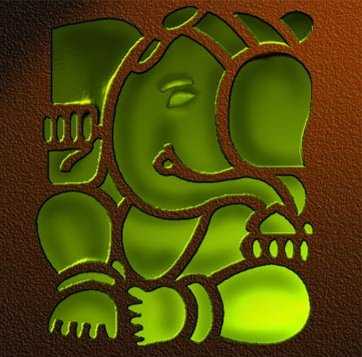
28. Gadadhara
Wielder Of The Mace
As Gadadhara, Lord Ganesha wields powerful weapons for destroying demons of evil. The gada or Mace is the divine weapon used to wipe out evil and slay the asuras.
29. Gajakarna
Elephant-Eyed
The elephant-eyed Ganesha is the embodiment of goodness and virtue, his size belying his non-violent nature. The small eyes radiate wisdom and compassion, powerful, yet gentle.
30. Gajanana
Elephant-Faced
Lord Ganesha in the form of Gajanana, with an elephant face, is deemed to be a very auspicious symbol, warding off possible mishaps and troubles. He stands for power and strength.
31. Gajananeti
Elephant-Faced
The elephant-faced Lord Ganesha is one-tusked, has a large, body with a huge belly, and is capable of destroying all obstacles'.
32. Gajavakra
Elephant Trunk
Ganesha with his twisted trunk is symbolic of his vast knowledge and powers of discrimination, vital for spiritual progress. The curved trunk is shaped like 'OM' also symbolic of the life force energy.
33. Gajavaktra
Elephant-Mouthed
The elephant-mouthed Ganesha is very fond of sweets. With a huge belly signifying wealth and the modaka sweet in his hand, symbolic of the sweetness of the realised Inner Self, he personifies love.
34. Ganadhakshya
Lord Of The Celestial Hordes
Lord Ganesha is the Chief of the group of gods, the. celestials. He is the first to be worshipped by the gods and mortals alike. He is the Lord of all he surveys, the Master of the earth, the universe, the cosmos, all creation.
35. Ganadhyakshina
Lord Of The Celestials
Lord Ganesha is the Lord of the gods and is the beloved of all. As the Chief and Supreme God among gods', he is worshipped by all.
36. Ganapati
Lord Of The Ganas
Lord Ganesha is also called Ganapati, the Lord of the celestial hordes. He is the Supreme Deity, Lord Almighty, who rules over the entire kingdom of the gods.

37. Gaurisuta
Son Of Gauri
Gauri is another name of Goddess Parvati. Gaurisuta is Lord Ganesha, the deft son of Gauri. He enlightens and causes his mother's face to blossom with his love and devotion.
38. Gunina
Lord Of All Virtues
Gunina, the Lord of all virtues, is Grace personified, making everything auspicious. His immense grace and radiance is supreme and ethereal, and is adored by one and all.
39. Haridra
The Golden One
Lord Ganesha, although smoke-coloured, is the Golden One, as he has a moon crest on his forehead, a sacred thread in the form of a serpent round his body, cheeks anointed with a vermilion paste, glowing golden like the rays of the sun.
40. Heramba
Beloved Of The Mother
Lord Ganesha is Heramba, the fire-headed Protector of the weak. He is his mother's beloved, and is her protector.
41. Kapil
Tawny-Coloured
The tawny-coloured elephant-faced Ganesha is the God of wisdom who teaches that the path of success and achievement is through the use of intellect, and that through wisdom alone can one reach salvation.
42. Kaveesha
Lord Of Poets
Ganesha is the Lord of wisdom from whom emanates knowledge that is divine. All poets invoke his grace before picking up their pens, for he is the Lord of poets from whose divine pen flow divine words.
43. Kirti
Lover Of Music
Lord Ganesha is Nada Brahman, Lord of music. He is the repository of knowledge and a mine of virtues from whom emanates illimitable erudition, and cosmic music and rhythm.
44. Kripakaram
Who Is Merciful
Lord Ganesha, as Kripakaram, wavy with profound kindness, is the sea exhibited by his eyes. He is ever Merciful and the beacon of divine fight.
45.Krishapingaksha
Black- Yellowish -Brown -Eyed
Lord Ganesha, whose, eyes radiate power, compassion, wisdom and love, is omnipotent and infinite. His small eyes dazzle with the exuberance of the fight of a million suns.

46. Kshamakaram
Abode Of Forgiveness
Constant and regular chanting of Lord Ganesha's name is a sure path for atonement of sins. He is the abode of forgiveness, the seat of compassion, and most forgiving. Repose faith in him and he will protect you.
47. Kshipra
Quick-Acting
Handsome of appearance and red in colour like the hibiscus flower, he holds his broken tusk, noose, goad, and sprig of the wish-fulfilling tree in his, hands and a pot of precious gems in his trunk.
48. Lambakarna
Large-Eared
The large-eared Ganesha is a mine of information gathered from all directions. His large ears are used for winnowing information, retaining only the essentials.
49. Lambodara
Huge-Bellied
The big-bellied Ganesha is the symbol of the whole universe-all that is conceivable in the whole cosmos- from which all events of the world emerge. It is symbolic of his capacity to assimilate the whole information.
50. Mahabala
Extremely Strong
Lord Ganesha, with his huge body, is symbolic of the cosmos or the universe. He is extremely strong and powerful, endowed with intellectual prowess.
51. Mahaganapati
The Omnipotent And All-Powerful
Lord Ganesha, the Almighty, the Supreme Infinite, is omnipotent and all powerful. His infinite form is beyond man's comprehension, and is limitless.
52. Maheshwaram
Lord Of The Universe
Maheshwaram, from whom the universe is born, is the Eternal Brahman. All the elements-earth, fire, air, water and ether-are manifest in him. He is the Supreme Lord of the universe.
53. Mangalamoorti
The Auspicious
Lord Ganesha is the personification of all that is auspicious. He who was worshipped by Lord Shiva before his vanquishing Tripurasur, by Lord Vishnu before his tying of Bali in the rope, by Lord Brahma before creating the world, by Parvati before her slaying the demon Manisha, is Mangalamoorti.
54. Manomay
Conqueror Of One's Heart
Lord Ganesha is the God of all people, big and small, educated and illiterate. He is compassionate and forgiving, wise and intellectual. With his huge body, gentle eyes and calm countenance, he fills one's heart with love.
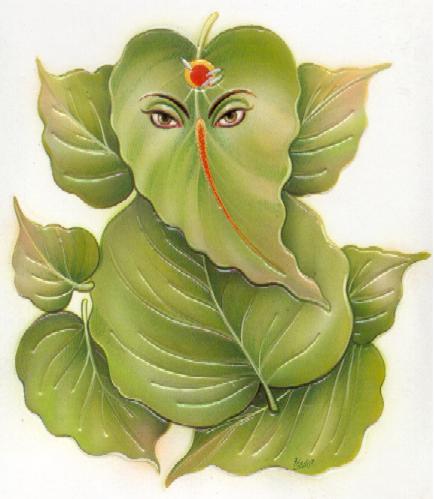
55. Mritunjaya
Deathless
The Infinite Lord Ganesha has no beginning or end. He is deathless and the root cause of the creation. He is the embodiment of 'OM', the symbol of the Great God who has no end and is invincible.
56. Mudakaram
Abode Of Joy
Lord Ganesha is the home of Siddhi and Buddhi, the repository of knowledge and the abode of joy. He bestows happiness and welfare to all.
57. Muktidaya
Giver Of Eternal Peace
Muktidaya is Lord Ganesha who grants security to his devotees, thereby providing eternal peace. He destroys all the obstacles that one may face when entreated by his devotees.
58. Musikvahan
He With The Mouse As His Vehicle
Lord Ganesha, with I his massive body, favours the Mouse as his beloved vehicle. The mouse, known to cause great havoc, is kept under the control of Ganesha by serving as his vehicle.
59. Nadapratithista
Lover Of Music
Lord Ganesha is symbolic of the music and rhythm of the cosmos. He loves music and sometimes a veena is one of the attributes seen in his hands. He is the patron of music and dance.
60. Namasthetu
Destroyer Of All Sins
Lord Ganesha is the sea-fire to end the sea. He purges the devotees of all sins by incinerating the sins and impieties by his holy fire.
61. Nandana
Son Of Lord Shiva
Nandana, son of Lord Shiva, is the mind-born son of Lord Shiva, or, as popularly believed, the creation of Parvati. He is the elder son of Shankara, and the beloved of his mother, Uma.
62. Nideeswaram
Master Of All Kinds Of Treasures
Lord Ganesha, the repository of knowledge, is adorable, with his plump body, his tusk broken and single. His is the Lord of all wealth-material as well as spiritual-endowed with intrinsic qualities that command the respect of all.
63. Pashin
One Who Sits Like A Rock
Lord Ganesha is Infinite and Consciousness personified, solid and unwavering like a rock, who is unshakeable, invincible, the seat of infinite power, the pure essence of luminous mind.
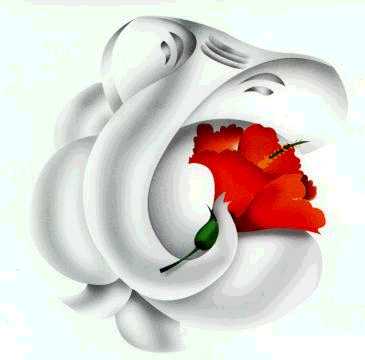
64. Pitambar
Wearer Of Yellow Clothes
Lord Ganesha, who wears clothe-5 of white and yellow, personifies purity and uniqueness. With a deep knowledge of the self, he is the eternal spirit who is changeless yet causes change all around.
65. Pramod
Lord Of The Place
As Pramod, Lord Ganesha is the only refuge of the shelterless as he is Lord of the place. He is the Lord of the gods, the repository of wisdom, the seat of spiritual awakening, from whom creation has come.
66. Prathameshvar
One Who Holds The First Place
Lord Ganesha, the eternal spirit, the Brahman, is the God of Auspiciousness, holding the first place. He is the Beginning of all beginnings, worshipped by Mahesha and other gods.
67. Purush
The Supreme Authority
Lord Ganesh is Punish, the Supreme Authority. He is the Omniscient Lord Almighty who rules over the entire universe. He is the Ultimate Reality, the One Truth, the Manifest Spirit.
68. Rakta
Red-coloured
Lord Ganesha's body hue is compared to the red lotus and his tusk to the vermilion blood marks when it is thrust into his enemies for destruction.
69. Rudrapriya
Beloved Of Shiva
Lord Ganesha, the beloved son of Shiva, is the Master of all, whose virtuous qualities are orisoned by even the creator, Brahma. He is Shiva's revered and noble son.
70. Sarvadevatman
Accepter Of Celestial Offerings
As Lord of the gods, Lord Ganesha is happy to accept the loving offerings of the celestials. They adore and worship him, and as their Master, and he bestows his grace on them.
71. Sarvasiddhanta
Provider of Adeptness To His Disciples
The repository of wisdom and knowledge, Lord Ganesha bestows success on his devotees. He who
chants his name continually will be sure of being blessed with the ability to be adept in all his actions.
72. Sarvatman
Blesser Of The Universe
He who dwells in every heart in a secret manner, by whose command this entire world exists, who is Infinite and the Enlighter of the hearts, by knowledge, he is Sarvatman, Lord Ganesha.
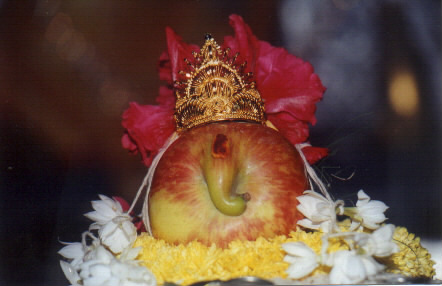
73. Shambhavi
Son Of Parvati
Lord Ganesha is the son of Lord Shankar and Goddess Parvati. He is the playfully deft son and is adored by his parents. He enlightens and causes his mother's face to blossom with love for him.
74. Shashivarnam
Moon -Complexioned
He who is attired in a white garment and who is all pervading, is Lord Ganesha, the elephant-faced Lord with a moon-complexion that glows brightly, indicating mental enlightenment, the moon being the symbol of peace.
75. Shoorpakarnai
Large-Eared
Lord Ganesha is the Lord with large ears. These large ears serve the purpose of gathering information from all possible directions. Like a winnowing basket, His ears are receptive and attuned to every mortal's cry of woe or praise.
76. Shuban
One Who Is Auspicious
A prayer to Lord Ganesha precedes all worship for he is auspicious and nothing can take place without invoking his name. For, he is the remover of obstacles in one's path, and the guarantor of success in. all ventures.
77. Shubhagunakanan
Mine Of All Virtues
Lord Ganesha is the Lord of all treasures and virtues; symbolic of perfection and infinite beauty he is compassionate, forgiving, endearing and protector of all that is good.
78. Shweta
White Colour
The huge-bellied Lord Ganesha, with an elephant face, a single-tusk which is askew, has his body and clothes white, being worshipped on the shore of ocean of milk with white flowers. His face beams the beatitude.
79. Siddhidhata
Bestower Of Success
The chanting of Lord Ganesha's name will pay rich dividends in the form of being bestowed with success. The Lord is the bestower of the desired abilities.
80. Siddhipriya
Bestower Of Boons
Siddhipriya is Lord Ganesha who grants the desires and boons of his devotees. Being compassionate and large-hearted the elephant-faced Ganesha fulfils the wishes of worshippers.
81. Siddhivinayaka
Bestower Of Success
Lord Ganesha's huge pot-belly is symbolic of wealth and success. He bestows both on his devotees, being the kind and compassionate Lord who grants them boons and showers them with success.
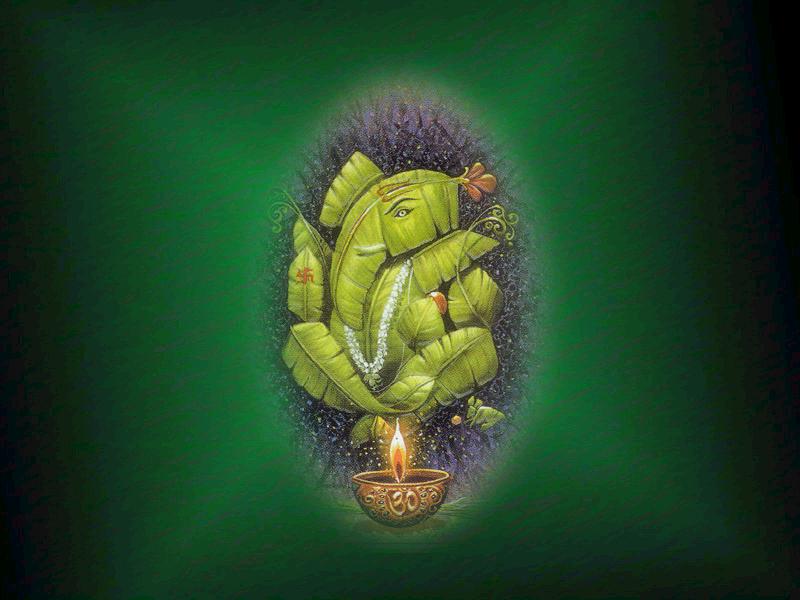
82. Skandapoorvaja
Older Than Skanda
Ganesha is the older son of Shiva and Parvati, and brother of Skanda (Karthik). He is the destroyer of the asura's pride, and protector of the weak and helpless. He protects and loves his brother Skanda.
83. Sumukha
Of Auspicious And Pleasant Visage
His strange visage is in the form of 'OM', the sound symbolic of the cosmic reality. Ganesha, with the bulky body, stands for the cosmos in its entirety. He is the symbol of auspiciousness.
84. Sureshwaram
Lord Of All The Gods
Sureshwaram is Lord Ganesha as Head of the ganas or celestials. He is the Supreme Being, the Foremost Being, the very cause of the creation of the cosmos Lord Almighty.
85. Swaroop
Lover Of Beauty
Lord Ganesha, the Master of resourcefulness and perfection in all spheres, is a lover of beauty. His awkward body signifies that outward form has no connection with inner beauty and spiritual perfection.
86. Tarun
The Youthful
The young Ganesha, ever youthful, is Wisdom personified. His huge body takes on the colour of red like the noonday sun, depicting the strength of, youth.
87. Uddanda
Punisher Of Evil
Uddanda is Lord Ganesha as punisher of evil. He also forgives those who seek his pardon. He is the vanquisher of demons and remover of all obstacles.
88. Umaputra
Son Of Uma
Uma, another name of Parvati, desired to have a son. Lord Shiva granted her wish and Ganesha took form. He is the beloved son of Uma, her delight, and obedient servant, ever ready to serve her.
89. Vakratunda
Askew-Trunked
Lord Ganesha, the single-tusked one, is attributed with an askew proboscis or trunk, which symbolises power, capable of destroying all obstacles and evil.
90. Varaganapati
Bestower Of Boons
Ganesha is the bestower of' all fruits of desire and granter of all adeptness that his worshippers seek. He is magnanimous and forgiving, being a wealth of knowledge and wisdom.

91. Varaprada
Granter Of Boons
Lord Ganesha grants boons to his devotees. He is most efficacious. He gives knowledge to the seeker of wisdom, prosperity to those desiring wealth, issues to the childless, and guidance to the attainment of spiritual liberation.
92. Varadavinayaka
Bestower Of Bounty And Success
The massive Ganesha, the granter of boons to his devotees, is the guarantor of success in all ventures. His devotees need never fear failure. As the benefactor of his devotees, he is greatly adored by them.
93. Veeraganapati
The Valiant Warrior
The red-complexioned Ganesha is sometimes attributed with eight pairs of arms, holding a bow, arrow, goblin, spear, hammer, mace, pick-axe, serpent, banner, trident, discus, goad, noose, battleaxe, sword and shield - all signs of a valiant warrior.
94. Vidyavaridhi
Repository Of All Knowledge
Lord Ganesha is the God of wisdom. He incinerates ignorance by his divine fire and enlightens by his knowledge. He is a goldmine of knowledge and wisdom.
95. Vignahara
Destroyer Of Evil
Vignahara is Lord Ganesha, who, like a vigorous wind, scatters away and destroys the dark clouds of evil. His name's mere recollection removes all sins.
96. Vignaharta
Destroyer Of Obstacles
Lord Ganesha is a veritable sceptre that destroys all obstacles. He is the destroyer of multitudes of obstacles, destroyer of all afflictions.
97. Vighnanashin
Destroyer Of Obstacles
The askew-trunked Ganesha, also called Vighnanashin, is the destroyer of all impediments. He is the destroyer of darkness created by' Obstacles.
98. Vighnaraja
Lord Of All Obstacles
The veritable sceptre to destroy all objects, Lord Ganesha is invincible. He is the inimitable jungle fire who destroys the jungle of troubles for his devotees. He is the destroyer of multitudes of obstacles.
99. Vighnarajendra
Lord Of All Obstacles
The noble Ganesha is the King of all the factors causing obstacles. He causes obstacles for the demons and enemies, causing them to stumble and be vanquished.
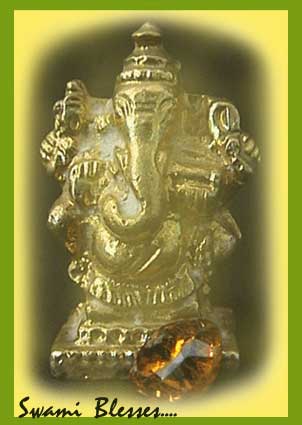
100. Vighnavinashanaya
Destroyer Of All Afflictions
The four-armed Ganesha is sometimes attributed with eight pairs of hands that are symbolic of destruction of evil. He protects his devotees by destroying all afflictions.
101. Vigneshwar
Lord Of All Obstacles
Vigneshwar, the only sun to destroy the darkness caused by obstacles, the only fire to incinerate the jungle of impediments, the only Garuda to browbeat the haughty snakes of troubles, is the Lord of all obstacles
102. Vikat
Of The Monstrous Figure
Lord Ganesha, the most adorable one, adored by all gods, is endowed with a huge, monstrous body, symbolising unity of the primeval forest denizen with man - combining the physical energies of mortals.
103. Vinayaka
Lord Of All
As Vinayaka, Lord Ganesha is the Supreme Leader of all, being endowed with special qualities. He is the Chief of all the celestial demi-gods, and is ever adored by them.
104. Vishwamukha
Lord Of The Universe
Lord Ganesha is the Supreme Reality, the Atman of all. He is the witness of all that is happening in the world. He is the Lord of the universe, the Supreme Being who has no beginning, who has no end.
105. Yagnakaya
Accepter of Sacrificial Fires
The calm and majestic Ganesha, with the strength and power of an elephant, is the Lord of the universe. He evokes great love and accepts the sacrificial fires offered to him by gods and mortals.
106. Yashaskaram
Giver Of Fame And Glory
Lord Ganesha is worshipped by both the devas and the asuras, for he is the Lord of the gods. He gives prosperity, fame and glory to-all the worlds, shining with a lustrous glow.
107. Yashvasin
The Popular
The pot-bellied, askew-trunked single-tusk Ganesha is popularly the beloved of all. He is the subject of those who sing his praise, the jewel from whose face flows nectar.
108. Yogadhipa
Lover Of Meditation
Lord Ganesha is the fountainhead of wisdom, the Great God ' that Eternal Truth, that Eternal Reality. His name is chanted at the beginning and end of meditation at all times.
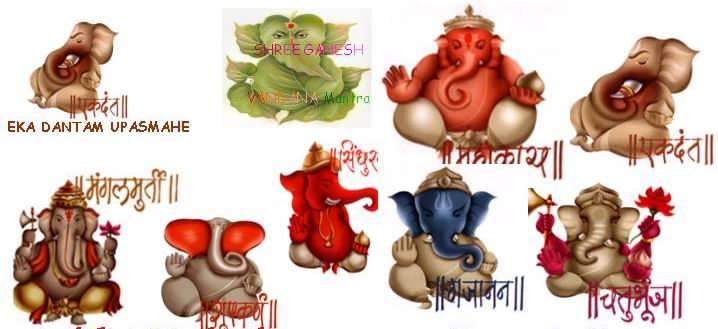

Shuklaambara Dharam Vishnum,
Shashi Varnam Chatur Bhujam,
Prasanna Vadanam Dhyaayet,
Sarva Vighna Upashaanthaye
Shashi Varnam Chatur Bhujam,
Prasanna Vadanam Dhyaayet,
Sarva Vighna Upashaanthaye
Vinayaka 108 Astothram | |
Om Vinaayakaaya namah | |
Om Vignaraajaaya namah | |
Om Gaureeputhraaya namah | |
Om Ganeshwaraaya namah | |
Om Skandaa-grajaaya namah | |
Om Avyayaaya namah | |
Om Poothaaya namah | |
Om Dakshaa-dhyakhsyaaya namah | |
Om Dwija priyaaya namah | |
Om Agni-garBha-chChide namah | |
Om Indra- shri-pradaaya namah | |
Om Vanee-pradaaya namah | |
Om Sarva Siddhi-pradaayakaaya namah | |
Om Sharva-thanayaaya namah | |
Om Gauri tanoojaaya namah | |
Om Sharvariee-priyaaya namah | |
Om Sarvaathmakaaya namah | |
Om Srashti-karthre namah | |
Om Deva-anekaarchithaaya namah | |
Om Shivaaya namah | |
Om Shuddhaaya namah | |
Om Buddhi priyaaya namah | |
Om Shaanthaaya namah | |
Om Brahma-Chaarine namah | |
Om Gajaananaaya namah | |
Om Dwai-maathuraaya namah | |
Om Munishthuthyaaya namah | |
Om Bhaktha vigna vinaashanaaya namah | |
Om Eka danthaaya namah | |
Om Chathur-baahave namah | |
Om Shakthi-samyuthaaya namah | |
Om Chaturaaya namah | |
Om Lambodaraaya namah | |
Om Shoorpakaranaaya namah | |
Om Herambhaaya namah | |
Om Brahma Vidhutthamaaya namah | |
Om Kaalaaya namah | |
Om Grahapataye namah | |
Om Kaamine namah | |
Om Somsooryagniyochanaya namah | |
Om Paashaankushdharaaya namah | |
Om Chandaaya namah | |
Om Gunaateetaaya namah | |
Om Niranjanaaya namah | |
Om Akalmashaaya namah | |
Om Svayamsidhaya namah | |
Om Siddharchidha padhampujaya namah | |
Om Beejaapura palasakthaya namah | |
Om Avyaktaaya namah | |
Om Gadine namah | |
Om Varadaaya namah | |
Om Sashvataaya namah | |
Om Kretine namah | |
Om Vidvapriyaaya namah | |
Om Veetabhayaaya namah | |
Om Chakrine namah | |
Om Ikshuchapadhrite namah | |
Om Abjothphalakaraaya namah | |
Om Shridhaaya namah | |
Om Stutiharshataaya namah | |
Om Kalaadhbrithe namah | |
Om Jatine namah | |
Om Chandrachoodaaya namah | |
Om Amarey varaaya namah | |
Om Nagayagnopavitine namah | |
Om Shrikanthaaya namah | |
Om Ramaarchitapadaaya namah | |
Om Viteene namah | |
Om Sthoolkanthaaya namah | |
Om Trayeekartre namah | |
Om Samghoshpriyaaya namah | |
Om Purushotamaaya namah | |
Om Sthooltundaaya namah | |
Om Agraganyaaya namah | |
Om Gramanye namah | |
Om Ganapaaya namah | |
Om Shiraaya namah | |
Om Vridhidaaya namah | |
Om Subhgaaya namah | |
Om Shorraaya namah | |
Om Vageeshaaya namah | |
Om Siddhidaaya namah | |
Om Durvabhilvapriyaaya namah | |
Om Kantaaya namah | |
Om Paapahaarine namah | |
Om Samaahitaaya namah | |
Om Vakratundaaya namah | |
Om Shripradaaya namah | |
Om Soumyaaya namah | |
Om Bhaktakankshithdaaya namah | |
Om Achutaaya namah | |
Om Kevalaaya namah | |
Om Siddhaaya namah | |
Om Sachidanandavigrahaaya namah | |
Om Gyanine namah | |
Om Dhayaayutaaya namah | |
Om Dantaaya namah | |
Om Brahmadveshaya namah | |
Om Vivarchitaaya namah | |
Om Pramartadaityabhayadaaya namah | |
Om Vyaktamoortaye namah | |
Om Amoorthimatheye namah | |
Om Parvathishankarotsangakhe lnotsavalaainaaya namah | |
Om Samastajagadadhaaraaya namah | |
Om mooshakavaahanaaya namah | |
Om Hrishtya namah | |
Om Stutaaya namah | |
Om Prasanaatmane namah | |
Om Sarvasiddhipradaayakaaya namah | |
Vinayaka (Ganesha) drives away all sorrows, difficulties, and miseries. He is the enemy of all obstacles. He will not allow any obstacles to come in the way. He is the destroyer of obstacles. He confers happiness and peace (on his devotees). He is the master of all these powers (intellect (buddhi) and fulfillment (siddhi, self-realization). What is this siddhi? When there is purity of mind, you achieve peace (which is siddhi). Vinayaka is thus the Lord of the intellect and self-realization. Hence, every human being should acquire control over the mind ... .
Vinayaka is the Lord of all learning (vidya). Does learning mean bookish scholarship? No. Everything pertaining to the cosmos is included in the term learning (vidya). Walking, talking, laughing, sitting, eating, strolling, thinking --every kind of activity is related to learning. Vinayaka is the master of every kind of learning. Today, learning is identified with acquisition of information. But apart from knowledge of the physical world, we have many other kinds of knowledge, relating to chemistry, the fine arts and other skills.
Vinayaka is the master of every kind of knowledge. Learning is related to the intellect (buddhi). It is not mere scholarship. Familiarity with books is not knowledge. One's entire life is a continuous process of learning. Any process of inquiry is related to learning. But basically our inquiry should be concerned with finding out what is transient and what is permanent. This is true knowledge.
Hence, today, students worship Vinayaka with zeal. Vinayaka is not the one who merely comes to the aid of those who read their books. He helps everyone at every step in life's journey.
Sanathana Sarathi, October 1995
From: A Compendium of the Teachings of Sathya Sai Baba, pp. 115
From: A Compendium of the Teachings of Sathya Sai Baba, pp. 115
Who is Vinayaka? In the verse (sloka) beginning with the words Suklaambara- dharam Vishnum, only the form of the deity is described. But there is another inner meaning for the name Vinayaka. Suklaambaradharam means one who is clad in white. Vishnum means he is all-pervading. Sasivarnam means his complexion is grey, like that of ash. Chathurbhujam means he has four arms. PrasannavadanamSarvavighnopasaanthaye means for the removal of all obstacles. Dhyaayeth means meditate (on him). Vinayaka is the deity who removes all bad qualities, instills good qualities, and confers peace on the devotee who meditates on him. means he has always a pleasing mien.
However, the Vinayaka-principle has only one meaning, which is relevant to everyone regardless of whether he is a believer or a non-believer. Vinayaka means that he is totally master of himself. He has no master above him. He does not depend on anyone. He is also called Ganapathi. This term means he is the lord of the ganas --a class of divine entities. This term also means that he is the master of the intellect and discriminating power in man. He possesses great intelligence and knowledge. Such knowledge issues from a pure and sacred mind. This knowledge leads to wisdom (vijnaana). Because he is the master of intelligence (buddhi) and wisdom or realisation ( siddhi), he is described as the Lord of Buddhi and Siddhi. Buddhi and Siddhi are referred to as the consorts of Vinayka.
The mouse is the vehicle of Vinayaka. What is the inner significance of the mouse? The mouse is considered as the embodiment of the sense of smell. The mouse is a symbol of the attachment to worldly tendencies (vasanas). It is well known that if you want to catch a mouse, you place a strong-smelling edible inside the mouse-trap. The mouse also symbolises the darkness of night. The mouse can see well in the dark. As Vinayaka's vehicle, the mouse signifies an object that leads man from darkness to light. Thus, the Vinayaka-principle means that which removes all the bad qualities, bad practices, and bad thoughts in men and inculcates good qualities, good conduct and good thoughts.
Another name for Vinayaka is Vighneswara. Easwara is one who is endowed with every conceivable form of wealth --riches, knowledge, health, bliss, beauty, etc. Vighneswara is the promoter of all these forms of wealth and removes all obstacles to their enjoyment. He confers all these forms of wealth on those who worship him. Vinayaka is described as "the first deity who should be worshipped (prathama vandana)". Since everyone in the world desires wealth and prosperity, everyone offers the first place for worship to Vighneswara.
Divine Discourse: Ganesh Chaturthi, 12 September 1991
What is the meaning of the name Ganapathi? Where are the ganas? What is their form? When you investigate this, you find that the five organs of perception and the five organs of action (jnaanendriyas and karmendriyas) are the ganas. The mind is the master over these ten organs. The intellect (buddhi) is the discriminating faculty above the mind. The ten senses, the mind, and the intellect together constitute the ganas.
In the word gana, ga stands for intellect (buddhi) and na means Vaijnaana (the higher knowledge or wisdom). Ganapathi is the Lord of the intellect and higher knowledge. The question may be asked, Are the intellect and higher knowledge present in the external world, or are they to be found within man? The answer is that he is present within each human being. There is no need to seek for him in the outside world. Ganapathi dwells in every human being in the form of intellect and wisdom.
When Ganapathi is described as "Parvathee thanaya", who is this Parvathee? Parvathee signifies Prithvi, Mother Earth. Everyone is a child of Mother Earth.
The meaning of "son of Parvathee (Parvatheethanaya)" is that Ganapathi, who is the Lord of the Ganas, is the son of Parvathee, who symbolizes the divine energy (sakthi).
The adoration of Parvathieeand Ganapathi is not of recent origin. Ganapathi is lauded at several places in the Rig Veda. This clearly shows that Ganapathi is as ancient as the Vedas.
In several places, Ganapathi is mentioned both in the Vedas and the Upanishaths. Many prayers are addressed to Ganapathi in the Narayanopanishath. There are also prayers to him in the Thaithiriya Upanishath. The Ganapathi Gayathri Mantra also figures in the Upanishath.
Ganapathi is called Vinayaka because there is no master above him. He is all powerful and independent. Without recognizing the esoteric significance of the Vinayaka Principle, people look only at the external form and offer worship in mundane terms.
What is the inner significance of worshipping the elephant-faced deity? The elephant is a symbol of might and magnitude. The elephant's foot is larger than that of any other animal. The elephant can make its way through the densest jungle. In this way, it signifies the quality of a leader who shows the way for others. The elephant is also known for its fidelity and gratitude. In any circumstance, it will not forget its master. Even in its last moments, if it hears the voice of its master, it will open its eyes and look for him. It will sacrifice its life for its master. These are the lessons man should learn from the elephant. Intelligence without gratitude is valueless. Every man should be grateful to those who have helped him.
Divine Discourse: Ganesh Chaturthi, 7 Sept 1997



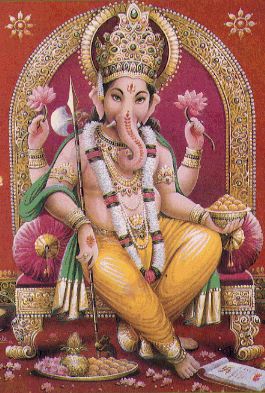












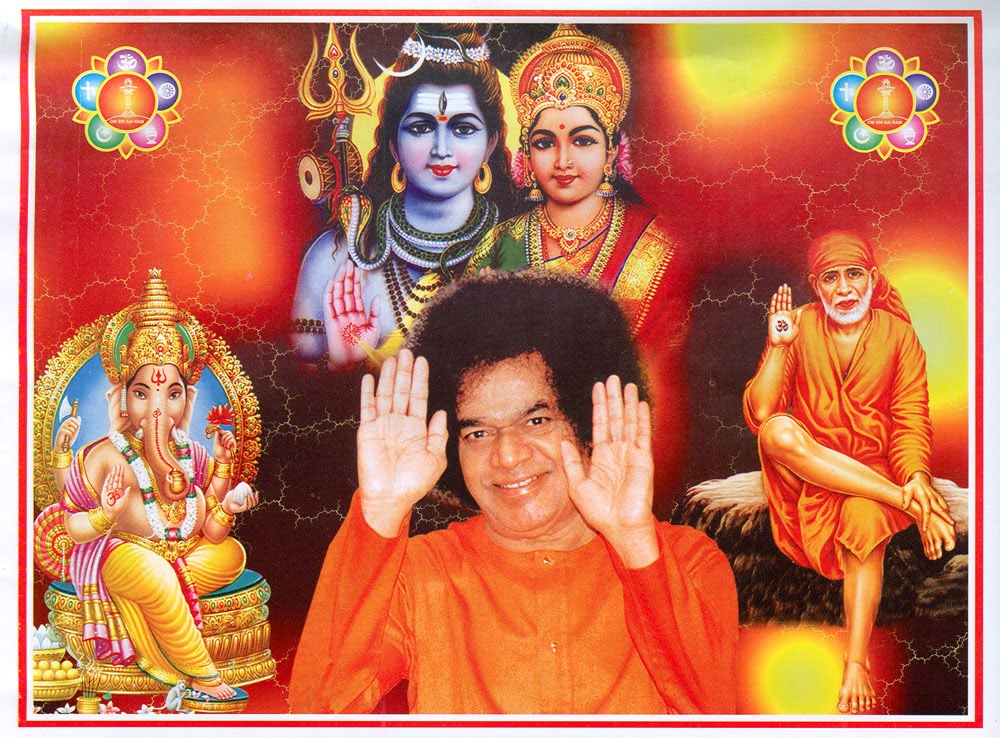







No hay comentarios :
Publicar un comentario